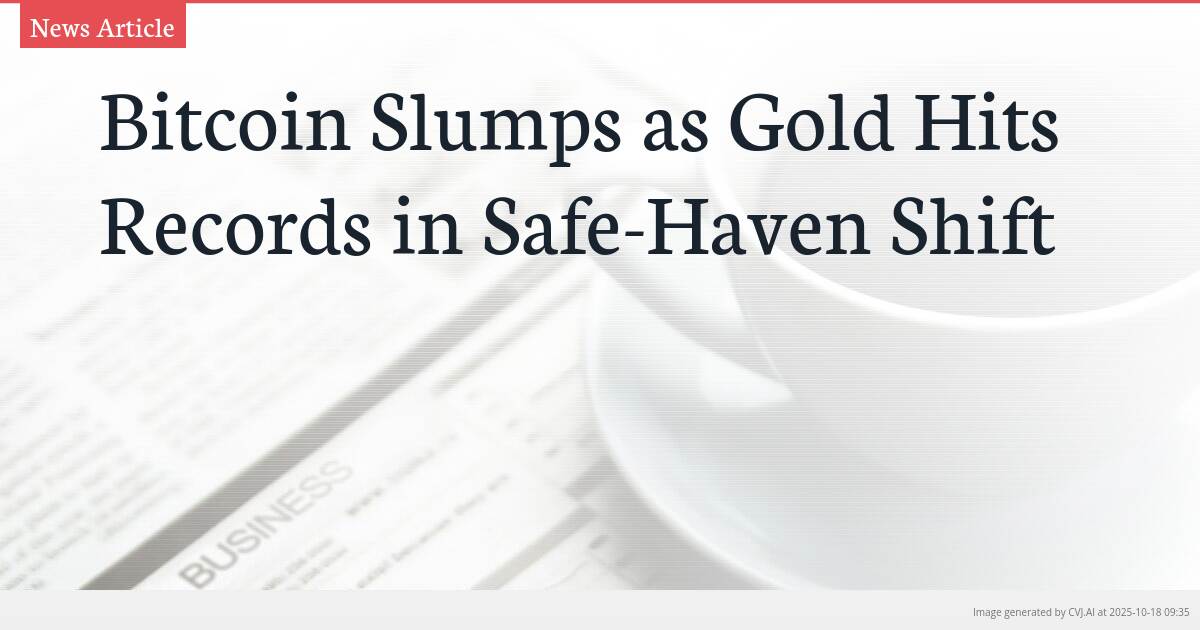This summary text is fully AI-generated and may therefore contain errors or be incomplete.
Introduction
Bitcoin tumbled more than 5% this week as investors fled risky assets for traditional safe havens. Gold surged to record highs above $4,300 per ounce while crypto markets faced heavy liquidations exceeding $1 billion. The divergence reignited debates about bitcoin’s viability as ‘digital gold’ during market stress, highlighting fundamental differences in how these assets behave when investors seek safety.
Key Points
- Crypto derivatives liquidations reached $1.23 billion in 24 hours, amplifying selling pressure
- Gold ETFs recorded strong inflows and reached long-term holding highs as investors sought safety
- Market stress revealed significant differences in liquidity and trading behavior between gold and cryptocurrencies
The Great Divergence: Crypto Plunge Meets Gold Rally
Financial markets witnessed a dramatic divergence this week as Bitcoin slipped more than 5% to about $105,105 on Friday, extending a slide that left it roughly 13% below its October 6 peak near $126,000. The cryptocurrency’s decline stood in stark contrast to gold’s performance, with the precious metal climbing to fresh records as spot gold pushed above $4,300 an ounce and hit a session peak near $4,312. US gold futures briefly traded around $4,328.70, reflecting a broad rush into traditional stores of value as investors weighed economic and geopolitical risks.
The scale of the crypto market’s downturn became evident through forced selling in derivatives markets, which amplified downward price moves. Reports indicated liquidations reached approximately $1.23 billion within a 24-hour span, with roughly $453 million tied to Bitcoin and another $277 million linked to Ethereum. This selling pressure created a vicious cycle where declining prices triggered more liquidations, further depressing cryptocurrency values. Meanwhile, gold appeared on track for its biggest weekly gain since 2008, underscoring the magnitude of the flight to safety.
ETF Flows Tell the Story of Investor Preference
Exchange-traded funds provided clear evidence of where institutional and retail money was moving during the market turmoil. Gold ETFs posted strong inflows, with some funds hitting long-term holding highs as capital sought safety in the traditional haven asset. This consistent buying pressure supported gold’s record-breaking performance and demonstrated the metal’s enduring appeal during periods of uncertainty.
In contrast, spot Bitcoin ETFs showed net outflows during parts of the week, highlighting a significant shift in where large pools of capital were being parked. The divergent ETF flows between gold and Bitcoin products revealed investor preferences in real-time, with money moving away from digital assets and toward established safe havens. This pattern reinforced gold’s status as a preferred destination for risk-averse capital during market stress, while raising questions about Bitcoin’s ability to attract defensive positioning.
The 'Digital Gold' Debate Intensifies
The contrasting performances of Bitcoin and gold reignited the longstanding debate about whether Bitcoin truly functions as ‘digital gold.’ Multiple market commentators pointed out that Bitcoin’s large price swings and its tendency to fall alongside other risky assets during market selloffs weaken its case as a reliable refuge. The cryptocurrency’s correlation with risk assets during this downturn challenged the narrative that it serves as an effective hedge during periods of market stress.
Still, some market participants maintained that Bitcoin has functioned as a valuable investment vehicle for certain investors this year, even if it doesn’t always match gold’s performance during crisis moments. The current market environment has made the differences in liquidity and trading behavior between gold and cryptocurrencies more obvious to observers, with gold’s deeper markets and more stable trading patterns providing advantages during turbulent periods.
Economic Drivers Behind the Safe-Haven Shift
Several economic forces combined to drive the capital rotation from cryptocurrencies to gold. Concerns about regional United States banks resurfaced, prompting investors to seek assets with proven safe-haven characteristics. Simultaneously, renewed debate over Federal Reserve interest-rate timing contributed to the risk-off sentiment, with uncertainty about monetary policy direction pushing investors toward traditional stores of value.
The market dynamics reflected broader concerns about economic stability and financial system resilience. As investors absorbed the implications of potential banking sector challenges and shifting Federal Reserve policy expectations, gold’s historical role as a crisis hedge came to the forefront. The precious metal’s ability to attract capital during such periods stood in sharp contrast to cryptocurrencies, which faced selling pressure as part of a broader reduction in risk exposure across financial markets.
What Comes Next for Both Assets
Market participants will be closely watching Federal Reserve signals and any fresh developments regarding United States banks for clues on where capital flows next. If expectations for interest rate cuts firm up, gold could continue its upward trajectory as lower rates typically enhance the appeal of non-yielding assets like precious metals. The metal’s strong momentum and record-breaking performance suggest it may maintain its attractiveness as long as economic uncertainties persist.
For Bitcoin and other cryptocurrencies, the path forward depends heavily on whether risk appetite returns to financial markets. If investor confidence improves, some of the capital that flowed out of crypto markets might reverse course. However, the recent wipeout has demonstrated that during periods of genuine market stress, a significant portion of investors still prefers traditional safe havens over digital alternatives. The episode has provided a clear lesson in how different asset classes respond when fear dominates market psychology.
📎 Read the original article on newsbtc.com

